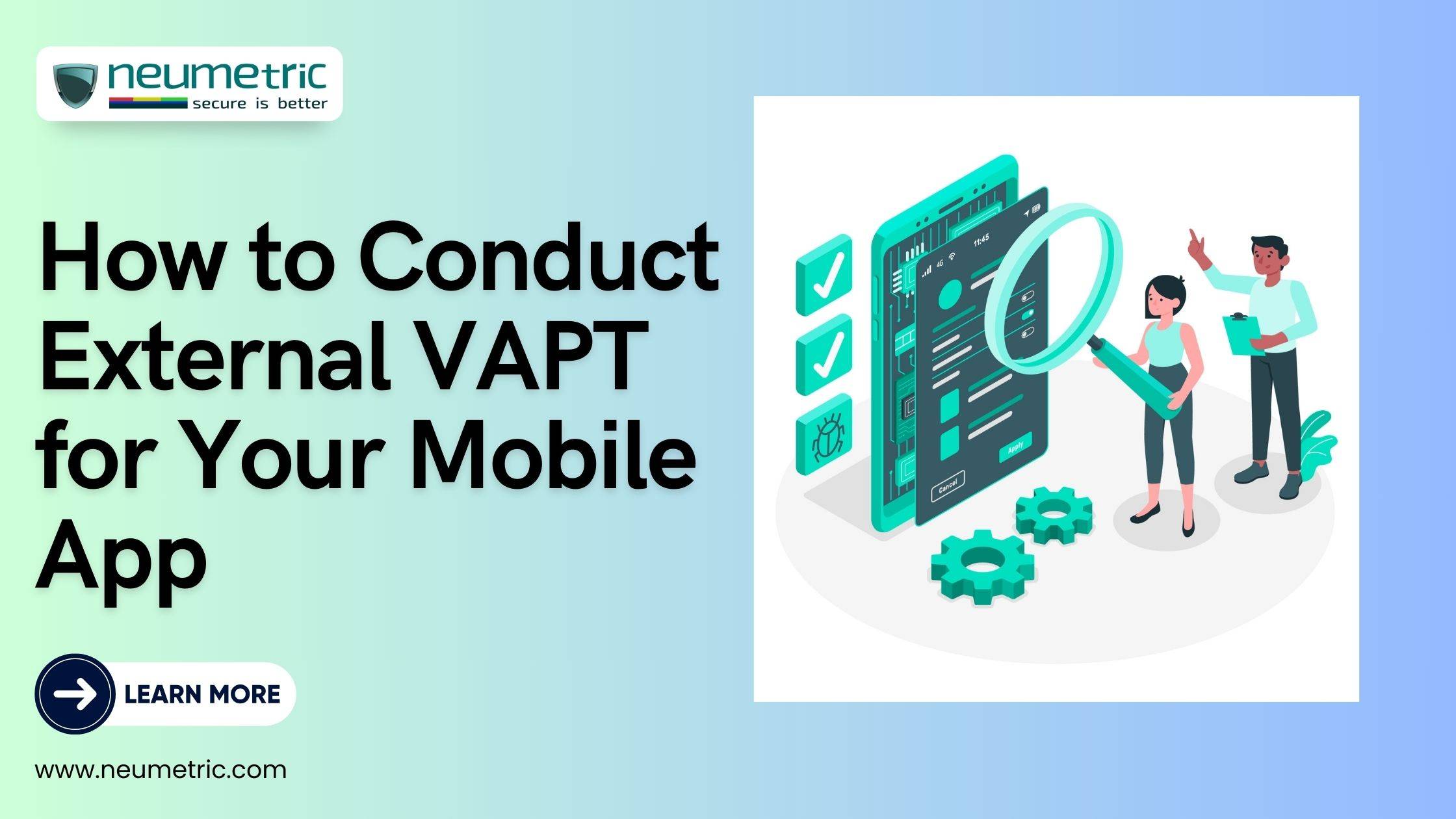Table of Contents
ToggleIntroduction
Mobile applications have become integral parts of our daily lives, handling sensitive information & performing various functions. With the increasing reliance on mobile apps, the security of these applications is of paramount importance. Mobile App Security involves implementing measures to protect mobile applications from potential threats & vulnerabilities, ensuring the confidentiality, integrity, & availability of data.
External VAPT, comprising Vulnerability Assessment & Penetration Testing, is a crucial aspect of securing mobile apps. It involves a comprehensive examination of the application’s security from an external perspective, simulating real-world cyber-attacks to identify vulnerabilities & weaknesses.
Understanding External VAPT
External Vulnerability Assessment & Penetration Testing are proactive measures to assess the security of a mobile app.
- Vulnerability Assessment (VA): This phase involves the systematic identification, quantification, & prioritisation of vulnerabilities within the mobile app.
- Penetration Testing (PT): Building on VA, Penetration Testing involves simulated cyber-attacks to exploit identified vulnerabilities, providing insights into potential security breaches.
While Internal VAPT focuses on evaluating an application’s security from within the organisation’s network, External VAPT is executed from an external, potentially adversarial perspective. External VAPT mimics the tactics of malicious hackers, probing the app’s defences as if it were exposed to the public internet.
- Real-world Simulation: External VAPT replicates real-world scenarios where attackers exploit vulnerabilities from outside the security perimeter. This ensures a holistic security assessment.
- Identifying External Threats: External VAPT helps in uncovering vulnerabilities that might be specifically exploited by external entities, including hackers & malicious actors attempting to compromise the mobile app remotely.
- Compliance Requirements: Many regulatory frameworks & industry standards mandate regular security assessments, making External VAPT essential for compliance.
- Protecting User Data: As mobile apps often handle sensitive user information, securing against external threats is crucial to maintaining the trust of users & safeguarding their data.
Preparing for External VAPT
Mobile app security starts with assessing the readiness of your application. Before conducting External VAPT, ensure that your app incorporates secure coding practices & robust data encryption measures. Implementing secure coding practices involves writing code in a way that prevents common vulnerabilities, such as injection attacks or insecure data storage. Additionally, robust data encryption ensures that sensitive information is protected from unauthorised access.
Building the right team for External VAPT is crucial. Decide whether to use in-house experts or external specialists. The team should consist of individuals with diverse skills, including ethical hackers, security analysts, & developers. Clearly define roles & responsibilities to ensure a smooth & effective testing process. This collaborative approach helps in identifying & addressing vulnerabilities comprehensively.
Choosing the Right Tools & Methodologies
Selecting appropriate tools is essential for a successful External VAPT. Various automated tools can assist in vulnerability scanning, while manual analysis provides a more in-depth understanding. The choice of tools depends on the complexity of your mobile app & the specific vulnerabilities you want to target.
Understanding different testing methodologies is crucial. External VAPT typically involves three approaches:
- Black Box Testing: Simulates an external cyber-attack without prior knowledge of the internal workings of the app.
- Grey Box Testing: Provides partial information about the app, offering a balance between black box & white box testing.
- White Box Testing: Involves detailed knowledge of the app’s internal architecture, allowing for a thorough assessment.
Creating a VAPT Plan
Clearly outline the objectives & scope of your External VAPT. Determine the specific goals of the testing, such as identifying vulnerabilities related to authentication, data storage, or communication.
Understand the potential threats your mobile app might face. This involves recognizing common vulnerabilities & industry-specific threats. By identifying these threats, you can tailor your testing to address the specific risks relevant to your application.
Set clear criteria for testing, including the platforms, devices, & network environments to be included. This ensures a comprehensive evaluation of your mobile app’s security.
Executing External VAPT
Begin with external reconnaissance to identify potential attack surfaces. Collect information about your mobile app from publicly available sources. This step is crucial for simulating real-world scenarios & understanding how attackers might approach your application.
Use automated tools for vulnerability scanning to identify potential weaknesses. Supplement this with manual analysis to ensure a thorough examination of your app’s security posture.
Simulate real-world attacks by exploiting vulnerabilities discovered during the testing process. This phase provides insights into the effectiveness of your app’s defences.
Analysing Test Results
After the testing phase, prioritise & classify vulnerabilities based on their severity & potential impact. This enables you to address critical issues promptly.
Generate comprehensive reports that include technical details of vulnerabilities along with remediation recommendations. These reports serve as a roadmap for addressing security concerns.
Addressing Vulnerabilities
Facilitate effective communication between the security team & development teams. This collaboration is vital for implementing fixes & patches promptly.
Implement a continuous monitoring system to detect & address new vulnerabilities. Regularly update your app’s security protocols to stay ahead of emerging threats.
Best Practices for Mobile App Security
Integrate security measures into every stage of the development lifecycle. This proactive approach minimises the introduction of vulnerabilities during the coding & deployment phases.
Stay proactive by regularly updating security protocols & measures. As technology evolves, so do potential threats. Regular updates ensure that your app remains resilient against emerging risks.
Educate your development & security teams on the latest security measures & best practices. Building awareness among team members enhances the overall security posture of your mobile app.
Conclusion
In conclusion, External VAPT is indispensable for ensuring the security of your mobile app. It provides a proactive approach to identifying & addressing vulnerabilities, ultimately safeguarding sensitive user data & maintaining the integrity of your application.
Encourage a proactive approach to mobile app security by integrating security practices throughout the development process. Prioritise regular testing, collaboration between teams, & staying informed about evolving security threats.
FAQs:
Why is External VAPT essential for my mobile app, & how does it differ from internal testing?
External VAPT is like the armor your mobile app needs in the digital battleground. It’s crucial because it simulates real-world attacks from outside your system, mimicking what a potential cybercriminal might try. Unlike internal testing that focuses on vulnerabilities within your organisation, External VAPT assesses how well your app can withstand threats from the outside world—keeping you a step ahead of potential attackers.
How can I ensure my mobile app is ready for External VAPT, & what role does the team play in this preparation?
Getting your app prepped for External VAPT is like gearing up for a marathon. It involves assessing your code’s security, ensuring robust data encryption, & assembling a squad of experts. Your team plays a pivotal role; whether it’s in-house or external, they need to be well-versed in secure coding practices & understand the intricacies of your app. It’s all about getting the right people on board to fortify your app’s defences.
What’s the deal with the different testing methodologies in External VAPT, & how do I choose the right one for my mobile app?
Think of testing methodologies like different approaches to solving a puzzle. In External VAPT, you’ve got Black Box, Grey Box, & White Box testing. Black Box is like solving the puzzle without knowing what it looks like; Grey Box is having a sneak peek, & White Box is knowing every nook & cranny. The choice depends on your app’s complexity & how much you want to reveal to the tester. It’s about finding the right fit for your app’s unique challenges.





